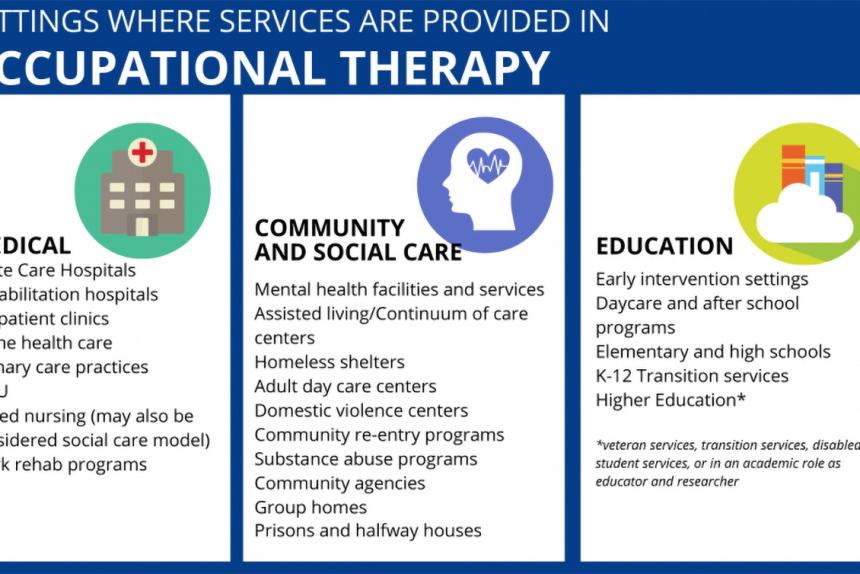Occupational Therapists (OTs) play a vital role in various environments, adapting to the specific needs of each setting. Understanding different occupational therapy settings is essential to grasp how OTs contribute to diverse communities and individuals. This guide is tailored for NBCOT® exam prep students eager to excel.
Understanding Occupational Therapy Settings
Occupational therapy work settings vary significantly, offering opportunities for OTs to engage in different roles such as manager, practitioner, consultant, lecturer, or researcher. Here’s a glimpse into some of the traditional and non-traditional environments where OTs can practice:
1. Traditional OT Settings
- Acute Care: Focuses on medically unstable patients requiring continuous support. It’s crucial for OTs to quickly assess and respond to patient needs in these dynamic environments.
- Acute Rehab: Engages patients who need intensive therapy, often up to three hours a day. The role here is pivotal in stabilizing and improving patient conditions, offering a solid foundation for further rehabilitation.
- Sub-Acute Rehab (SAR): Assists patients who need medical attention but can’t handle prolonged therapy sessions like in acute rehab. Here, OTs still provide essential rehabilitative care and support.
- Skilled Nursing Facility (SNF): OTs help patients who require significant medical attention in a more permanent care setting, focusing on maintaining or improving quality of life.
- Home Health OT Services: Patients here are homebound, and OTs must adapt practices to fit the home setting, offering personalized, crucial care.
Want detailed practice tips to ace the NBCOT® exam? Join now for full access!
2. Non-Traditional OT Settings
- Vocational Rehab: OTs focus on assisting clients in finding suitable employment opportunities, addressing both cognitive and physical challenges.
- Pre-Vocational Training: Preparing clients for future employment by honing independent living and vocational skills. Although not a direct OT setting, OTs can contribute significantly to these programs.
- Transitional Employment: Provides an internship-like experience, helping clients refine job skills in a practical setting.
- Clubhouse: Functions as a supportive day treatment environment emphasizing client strengths over diagnoses, fostering a community-driven recovery path.
In our full guide, we break down each developmental group with case examples and quizzes. Engaging with these materials can significantly boost your understanding and application of OT practice settings.
Interactive Learning and Exam Strategies
- Practice task-oriented group activities weekly to deepen your practical understanding.
- Use developmental group case studies to explore various OT scenarios and solutions.
- Engage with our interactive quizzes to reinforce your knowledge and prepare for real-world applications.
Utilize these insights and begin your structured preparation today! Enhance your exam readiness and career success by diving deeper into each type of occupational therapy setting explored here.
Curious about specific occupational therapy settings? Join now for exclusive resources and full access!
What are traditional occupational therapy settings?
Traditional occupational therapy settings include acute care, acute rehab, sub-acute rehab, skilled nursing facilities, and home health OT services. Each setting allows OTs to cater to different patient needs, whether it’s providing continuous support in acute care or offering personalized care in a home environment.
How can OTs contribute in non-traditional settings?
In non-traditional settings, OTs can work in vocational rehab, pre-vocational training, transitional employment, and clubhouse environments. Their role involves helping clients prepare for employment, refine job skills, and foster a community-driven recovery path.
What strategies can enhance NBCOT exam preparation?
Enhance your NBCOT exam preparation by engaging in task-oriented group activities, utilizing developmental group case studies, and taking interactive quizzes. These strategies are designed to deepen practical understanding and reinforce knowledge for real-world applications.
Why is understanding different OT settings important?
Understanding different OT settings is crucial because it allows you to grasp the diverse roles OTs play in various environments. This knowledge is essential for applying OT skills effectively, whether in traditional or non-traditional settings, and contributes to career success.
Where can I find resources for practicing OT settings?
You can access detailed practice tips and resources by joining the platform mentioned in the guide. Full access includes developmental group examples, quizzes, and insights on various OT scenarios. Joining now will enhance your exam readiness and understanding of OT practice settings.



